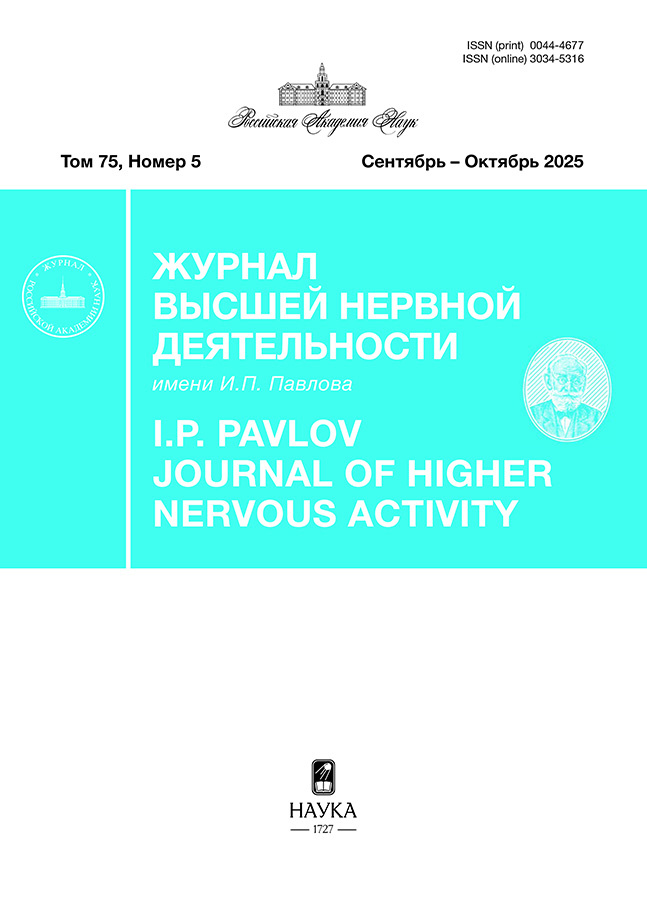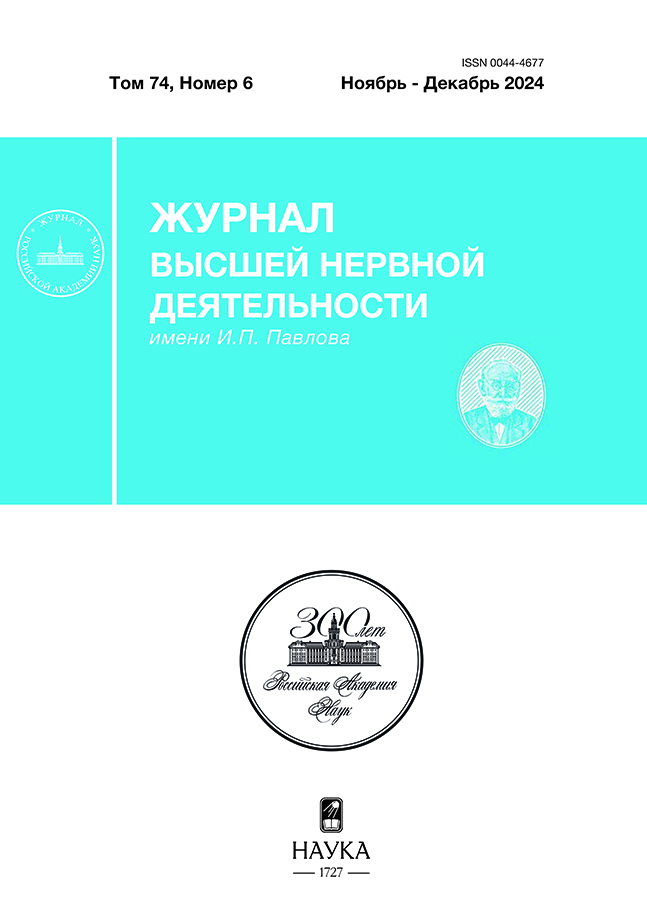Смещение внимания в парадигме эмоционального Струп теста у девушек с вегетативной дисфункцией различной выраженности
- Авторы: Михайлова Е.С.1, Кушнир А.Б.1, Герасименко Н.Ю.1
-
Учреждения:
- ФГБУН «Институт высшей нервной деятельности и нейрофизиологии Российской академии наук»
- Выпуск: Том 74, № 6 (2024)
- Страницы: 701-716
- Раздел: ФИЗИОЛОГИЯ ВЫСШЕЙ НЕРВНОЙ (КОГНИТИВНОЙ) ДЕЯТЕЛЬНОСТИ ЧЕЛОВЕКА
- URL: https://cardiosomatics.orscience.ru/0044-4677/article/view/652064
- DOI: https://doi.org/10.31857/S0044467724060054
- ID: 652064
Цитировать
Полный текст
Аннотация
В группе из 49 девушек в экспериментальной модели эмоционального теста Струпа исследовали влияние нерелевантной информации на внимание и его контроль в зависимости от уровня сомато-вегетативных изменений (выраженные, умеренные, отсутствие). Испытуемые выполняли задачу опознания мимических выражений гнева, страха и отвращения, затрудненную наложением на изображения лиц напечатанных слов – названий эмоций, конгруэнтных или неконгруэнтных предъявляемой лицевой экспрессии. Результаты показали, что наличие вегетативной дисфункции ухудшает контроль внимания, затрудняет подавление нерелевантной задаче словесной информации, приводит к смещению внимания, количественно определяемому по величине Струп-эффекта. Струп-эффект был максимален в группе девушек с более выраженными изменениями сомато-вегетативной сферы. Среди использованных в работе негативных эмоций отвращение оказалось наиболее эффективным для анализа влияния вегетативной дисфункции на смещение внимания.
Ключевые слова
Полный текст
Об авторах
Е. С. Михайлова
ФГБУН «Институт высшей нервной деятельности и нейрофизиологии Российской академии наук»
Автор, ответственный за переписку.
Email: mikhailovaes@gmail.com
Россия, Москва
А. Б. Кушнир
ФГБУН «Институт высшей нервной деятельности и нейрофизиологии Российской академии наук»
Email: mikhailovaes@gmail.com
Россия, Москва
Н. Ю. Герасименко
ФГБУН «Институт высшей нервной деятельности и нейрофизиологии Российской академии наук»
Email: mikhailovaes@gmail.com
Россия, Москва
Список литературы
- Алипов Н.Н., Белякова-Бородина А.И., Гордеев С.А., Ковров Г.В., Посохов С.И., Присуха Н.С., Помазан И.А. Исследование вегетативного статуса и эмоционально-личностной сферы студентов-медиков 2 курса. Вестник неврологии, психиатрии и нейрохирургии. 2015. 1: 38–43.
- Алипов Н.Н., Гордеев С.А., Присуха Н.С., Черемушкин Е.А., Петренко Н.Е., Ковров Г.В., Посохов С.И., Алипова В.Н., Сергеева О.В., Тверская М.С. Психовегетативный профиль у студентов-медиков младших курсов: результаты трехлетнего исследования. Вестник неврологии, психиатрии и нейрохирургии. 2017. 12: 25–30.
- Вегетативные расстройства: Клиника, диагностика, лечение. Ред. Вейн А.М. М.: Медицинская психология, 2003. 640 с.
- Гордеев С.А., Ковров Г.В., Посохов С.И., Катенко С.В. Психофизиологические особенности пароксизмальных расстройств неэпилептической природы. Журн. высш. нерв. деят. им. И.П. Павлова. 2014. 64 (1): 41–53.
- Чутко Л.С., Сурушкина С.Ю., Яковенко Е.А., Анисимова Т.И., Карповская Е.Б., Василенко В.В., Дидур М.Д., Волов М.Б. Нарушения когнитивного контроля у пациентов с соматоформными расстройствами и их лечение. Журнал неврологии и психиатрии им. С.С. Корсакова. 2019. 119 (4): 32–37.
- Algom D., Chajut E. Reclaiming the Stroop Effect back from control to input-driven attention and perception. Front. Psychol. 2019. 10: 1683.
- Banich M.T. The Stroop Effect occurs at multiple points along a cascade of control: evidence from cognitive neuroscience approaches. Front. Psychol. 2019. 10: 2164.
- Bar-Haim Y., Lamy D., Pergamin L., Bakermans–Kranenburg M.J., van IJzendoorn M.H. Threat-related attentional bias in anxious and nonanxious individuals: a meta-analytic study. Psychol. Bull. 2007. 133 (1): 1–24.
- Barkley R.A. Behavioral inhibition, sustained attention, and executive functions: Constructing a unifying theory of ADHD. Psychol. Bull. 1997. 121 (1): 65–94.
- Barsky A.J., Borus J.F. Somatization and medicalization in the era of managed care. JAMA. 1995. 274 (24): 1931–1934.
- Beck A.T., Clark D.A. An information processing model of anxiety: automatic and strategic processes. Behav. Res. Ther. 1997. 35 (1): 49–58.
- Beck A.T., Ward C.H., Mendelson M., Mock J., Erbaugh J. An inventory for measuring depression. Arch. Gen. Psychiatry. 1961. 4: 561–571.
- Becker E.S., Rinck M., Margraf J., Roth W.T. The emotional Stroop effect in anxiety disorders: general emotional or disorder specificity? J. Anxiety Disord. 2001. 15 (3): 147–159.
- Braem S., Bugg J.M., Schmidt J.R., Crump M.J.C., Weissman D.H., Notebaert W., Egner T. Measuring adaptive control in conflict tasks. Trends Cogn. Sci. 2019. 23 (9): 769–783.
- Charash M., McKay D. Disgust and Contamination Fear: Attention, Memory, and Judgment of Stimulus Situations. Int. J. Cogn. Ther. 2009. 2(1):53–59.
- Chechko N., Augustin M., Zvyagintsev M., Schneider F., Habel U., Kellermann T. Brain circuitries involved in emotional interference task in major depression disorder. J. Affect. Disord. 2013. 149 (1–3): 136–145.
- Cisler J.M., Olatunji B.O., Feldner M.T., Forsyth J.P. Emotion regulation and the anxiety disorders: An integrative review. J. Psychopathol. Behav. Assess. 2010. 32 (1): 68–82.
- Darwin C. The expression of the emotions in man and animals. London: John Murray, 1872.
- Ekman P., Levenson R.W., Friesen W. V. Autonomic nervous system activity distinguishes among emotions. Science. 1983. 221 (4616): 1208–1210.
- Eysenck M.W., Derakshan N., Santos R., Calvo M.G. Anxiety and cognitive performance: attentional control theory. Emotion 2007. 7 (2): 336–353.
- Favre P., Polosan M., Pichat C., Bougerol T., Baciu M. Cerebral correlates of abnormal emotion conflict processing in euthymic bipolar patients: A functional MRI study. PLoS One. 2015. 10 (8): e0134961.
- Gray J.A. The psychology of fear and stress, 2nd ed. 1987.
- Henik A., Salo R. Schizophrenia and the Stroop Effect. Behav. Cogn. Neurosci. Rev. 2004. 3 (1): 42–59.
- Holmes A., Nielsen M.K., Tipper S., Green S. An electrophysiological investigation into the automaticity of emotional face processing in high versus low trait anxious individuals. Cogn. Affect. Behav. Neurosci. 2009. 9 (3): 323–334.
- Huang W.-L., Liao S.-C., Gau S.S.-F. Association between Stroop tasks and heart rate variability features in patients with somatic symptom disorder. J. Psychiatr. Res. 2021. 136: 246–255.
- Iordan A.D., Dolcos S., Dolcos F. Neural signatures of the response to emotional distraction: a review of evidence from brain imaging investigations. Front. Hum. Neurosci. 2013. 7: 200.
- Joyal M., Wensing T., Levasseur-Moreau J., Leblond J., T Sack A., Fecteau S. Characterizing emotional Stroop interference in posttraumatic stress disorder, major depression and anxiety disorders: A systematic review and meta-analysis. PLoS One 2019. 14 (4): e0214998.
- Kalanthroff E., Henik A., Derakshan N., Usher M. Anxiety, emotional distraction, and attentional control in the Stroop task. Emotion 2016. 16 (3): 293–300.
- Klein R.J., Liu T., Diehl D., Robinson M.D. The personality-related implications of Stroop performance: Stress-contingent self-control in daily life. J. Res. Pers. 2017. 70: 156–165.
- Krusemark E.A., Li W. Do all threats work the same way? Divergent effects of fear and disgust on sensory perception and attention. J. Neurosci. 2011. 31 (9): 3429–3434.
- Langner O., Dotsch R., Bijlstra G., Wigboldus D.H.J., Hawk S.T., van Knippenberg A. Presentation and validation of the Radboud Faces Database. Cogn. Emot. 2010. 24 (8): 1377–1388.
- La Rosa A.O., Mir J.R. On the relationships between disgust and morality: a critical review. Psicothema 2013. 25 (2): 222–226.
- Lim S.-L., Kim J.-H. Cognitive processing of emotional information in depression, panic, and somatoform disorder. J. Abnorm. Psychol. 2005. 114 (1): 50–61.
- MacLeod C.M. The Stroop task: The “gold standard” of attentional measures. J. Exp. Psychol. Gen. 1992. 121 (1): 12–14.
- Morel S., George N., Foucher A., Chammat M., Dubal S. ERP evidence for an early emotional bias towards happy faces in trait anxiety. Biol. Psychol. 2014. 99: 183–192.
- Mikhailova E., Karpova V., Gerasimenko N., Gordeev S., Kushnir A. Facial emotion perception in young female students with subsyndromal panic disorder. Behavioral and ERP study. Biol. Psychol. 2021. 162:108084.
- Neuberg S., Kenrick D., Schaller M. Human Threat Management Systems: Self-Protection and Disease Avoidance. Neurosci. Biobehav. Rev. 2011. 35: 1042–1051.
- Nuño L., Gómez-Benito J., Carmona V.R., Pino O. A systematic review of executive function and information processing speed in major depression disorder. Brain Sci. 2021. 11 (2).
- Oaten M., Stevenson R.J., Case T.I. Disgust as a disease-avoidance mechanism. Psychol. Bull. 2009. 135 (2): 303–321.
- Parris B.A., Hasshim N., Wadsley M., Augustinova M., Ferrand L. The loci of Stroop effects: a critical review of methods and evidence for levels of processing contributing to color-word Stroop effects and the implications for the loci of attentional selection. Psychol. Res. 2022. 86 (4): 1029–1053.
- Pollatos O., Herbert B.M., Wankner S., Dietel A., Wachsmuth C., Henningsen P., Sack M. Autonomic imbalance is associated with reduced facial recognition in somatoform disorders. J. Psychosom. Res. 2011. 71 (4): 232–239.
- Rozin P., Fallon A.E. A perspective on disgust. Psychol. Rev. 1987. 94 (1): 23–41.
- Rief W., Broadbent E. Explaining medically unexplained symptoms–models and mechanisms. Clin. Psychol. Rev. 2007. 27 (7): 821–841.
- Schwartz K., Verhaeghen P. ADHD and Stroop interference from age 9 to age 41 years: A meta-analysis of developmental effects. Psychol. Med. 2008. 38 (11): 1607–1616.
- Smolker H.R., Wang K., Luciana M., Bjork J.M., Gonzalez R., Barch D.M., McGlade E.C., Kaiser R.H., Friedman N.P., Hewitt J.K., Banich M.T. The Emotional Word-Emotional Face Stroop task in the ABCD study: Psychometric validation and associations with measures of cognition and psychopathology. Dev. Cogn. Neurosci. 2022. 53: 101054.
- Spielberger C.D., Gorsuch R.L., Lushene R., Vagg P.R., Jacobs G.A. Manual for the State-Trait Anxiety Inventory. Palo Alto, CA: Consulting Psychologists Press, 1983.
- Spieler D.H., Balota D.A., Faust M.E. Stroop performance in healthy younger and older adults and in individuals with dementia of the Alzheimer’s type. J. Exp. Psychol. Hum. Percept. Perform. 1996. 22 (2): 461–479.
- Stroop J.R. Studies of interference in serial verbal reactions. J. Exp. Psychol. 1935. 18 (6): 643–662.
- Vermeulen N., Godefroid J., Mermillod M. Emotional modulation of attention: fear increases but disgust reduces the attentional blink. PLoS One. 2009. 4: e7924.
- Williams J.M.G., Watts F.N., MacLeod C., Mathews A. Cognitive psychology and emotional disorders. 1988.
- Wu Y., Ma S., He X., Xiang S., Qi S. Trait anxiety modulates the temporal dynamics of Stroop task switching: An ERP study. Biol. Psychol. 2021. 163: 108144.
Дополнительные файлы
















